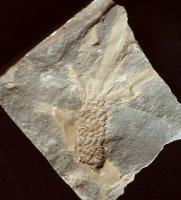| The first Ginkgo-like plants are found in the Permian. They
had strongly divided leaflets, which were connected at the base. Also in
this Lower Liassic flora the leaflets are still deeply incised.
|
 Ginkgoites
(Baiera) taeniata and Sphenobaiera
spectabilis. Ginkgoites
(Baiera) taeniata and Sphenobaiera
spectabilis. Both species have leaflets which are divided dichotomously several times. The partial leaflets are linear and have parallel veins. Ginkgoites has relatively small leaves with fine partial leaflets and a distinctive petiole. Sphenobaiera has much larger leaves in which the partial leaflets are also bigger than in the preceding species. The leaf does not have a petiole but is narrowing to the base. We have found only some (not very spectacular) leaflets of the first species. |
 Schmeissneria
microstachys Schmeissneria
microstachys is a plant only recently described in 1994 on the basis of specimens found by the amateur Schmeißner. The leaves are sitting at the end of short thick twigs (short-shoots) with a length of 2 to 5 cm. The leaves themselves are elongated with a blunt top and they have parallel veins. In between the leaves female spikes are sometimes present. |
 Stachyiopitys preslii Stachyiopitys preslii is probably the male fructification of this plant. However, it has not yet been found attached to it. There is discussion wether Schmeissneria could be an early flowering plant. We have not found this plant ourselves. |